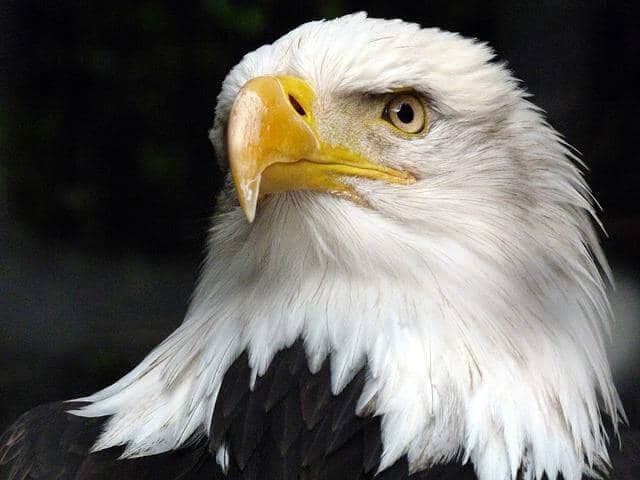Are you confused about how the bald eagle got its name? As you may have seen, its appearance doesn’t quite match up. Right?
Here, I will explain to you why a bald eagle is called bald, who named it bald eagle, is it really bald, and the difference between bald eagle and an eagle. Also, I will share with you some cool facts about bald eagles. Excited to read? Let’s begin!
Recommended Birdwatching Equipment:

|
Check Here (on Amazon)
|

|
Check Here (on Amazon)
|
|
Check Here (on Amazon)
|
Why Are Bald Eagles Called Bald?
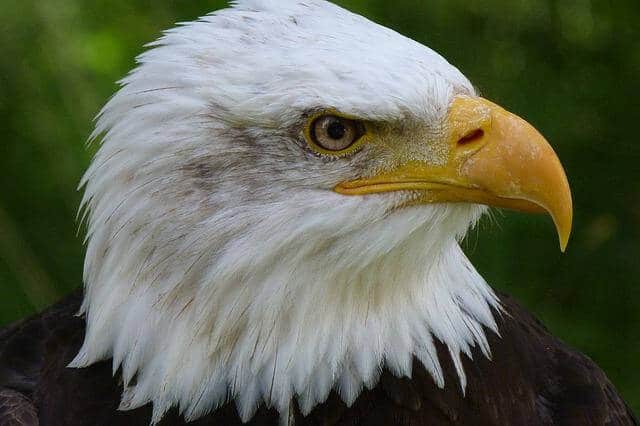
From its name, it’s easy to assume that bald eagles have bald heads.
However, ‘bald’ actually stems from an old English word ‘balde’, meaning white. The name is also closely related to another old English word, ‘piebald’, which means white-headed. So as you can see, the eagle wasn’t given its name due to baldness, but actually because of its white-feathered head.
The animal’s scientific name is Haliaeetus leucocephalus. When broken down, they translate into four Greek root words; hali (meaning salt), aeetus (meaning eagle), leuco (meaning white), and syphilis (meaning head). When you put all of that together, technically the direct translation is ‘white-headed sea eagle’.
Both its common and scientific name are derived from the bird’s distinctive appearance. With ‘bald’ meaning white, rather than hairless, and ‘piebald’ referring to its dark body and light head.
Who Named The Bald Eagle ‘The Bald Eagle’?
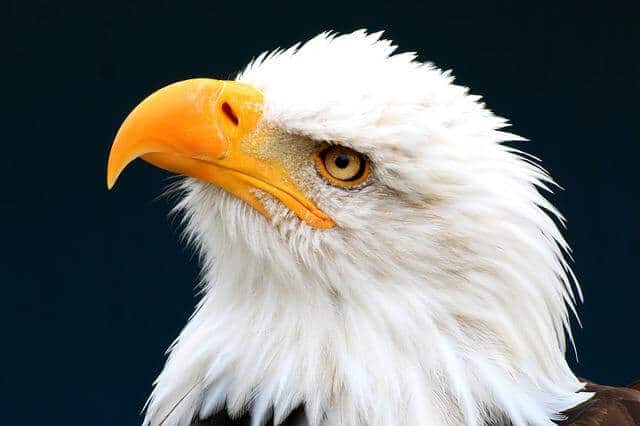
Whoever came up with the name ‘bald eagle’ is unknown, therefore it is uncredited. However, Swedish botanist and explorer Carl Linnaeus was the first person to officially describe the bald eagle in his 18th-century work titled ‘Systema Naturae’. At the time, he called them Falco leucocephalus.
The word ‘eagle’ itself is an ancient Norman name, used in Britain in 1066 after the conquest of the island. The term was given to a person who exhibited characteristics similar to an eagle, such as an impressive nature, sharp-eyed vision, or lordliness.
Are Bald Eagles Actually Bald?
Despite frequent confusion (mostly due to the name), bald eagles are not actually bald. Nor do they particularly look bald when they are fledging. A fully grown bald eagle has a white-feathered head, a brown body, then yellow eyes, feet, and beak.
Read: How Long Do Bald Eagles Stay With Their Parents?
What Is the Difference Between a Bald Eagle and an Eagle?
Although both birds have dark brown bodies, the main difference is that the bald eagle has a white head. The golden eagle has a brown head with golden-like feathers on the back of its neck. Furthermore, the bald eagle has a yellow beak, while the golden eagle has a black beak.
The last notable difference is that golden eagles have feathers all the way down their tarsi (legs), referred to as ‘booted eagles’, whereas a bald eagle’s feathers will stop a few inches before their feet.
Below I have created a chart to clearly highlight the key differences between a bald eagle and an eagle.
| Bald Eagle | Golden Eagle | |
| Head | White-feathered. Slightly bigger and more elongated. | Brown head with ‘golden’ feathers on the back of its neck. Smaller-sized head. |
| Legs | Feathers stop a few inches before the feet. | Feathers all the way down the tarsi, known as ‘booted eagles’. |
| Beak | A bigger yellow beak. | A smaller black beak. |
| Feathers | Spotted-pattern. | Marbled-pattern. |
| Flight | Hold their wings flatter and have deeper wingbeats. | Hold wings slightly more curved and have lighter wingbeats. |
| Diet | Most commonly eats fish or small animals. | Do not usually hunt over water, preys on larger mammals up to 4kg. |
| Habitat | Only found in Northern America. | Can be found worldwide in Northern Africa, Northern America, Europe, the UK, and Asia. |
| Genus | Haliaeetus (sea eagle) | Aquila (true eagle) |
It is much harder to distinguish the difference between immature birds. Since bald eagles have a brown head until they are at least 4, they are often mistaken for golden eagles. The best way to tell them apart at this age is by their plumages (underbelly). Bald eagles will have patches of white, whereas the golden eagle is mainly brown.
Cool Facts About Bald Eagles
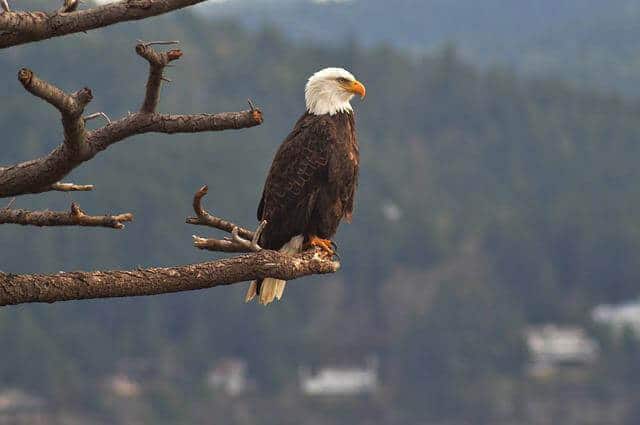
#1. Male bald eagles are smaller than females. For a male, their average weight can be anywhere from 9 to 10 pounds with a wingspan of 5.5 to 6 feet. However, female bald eagles weigh between 10 and 14 pounds and have a wingspan of 6 to 7 feet. On average, female bald eagles are 25% heavier than males.
#2. Bald eagles generally mate for life. They pick their partner through a courtship procedure, using various calls and aerial displays. They build their nests together, almost as a way of bonding, which can take them up to 3 months. If one mate dies, the other may then go and find a new partner.
#3. Bald eagles hold the world record for largest aerie (or nest). On average, their nests are 4 to 5 feet in diameter and 2 to 4 feet deep. However, the biggest on record was built by a pair of bald eagles in St Petersburg, Florida. The aerie reached a massive 9 feet in diameter, and 6 metres in depth. It weighed a total of 2 tons.
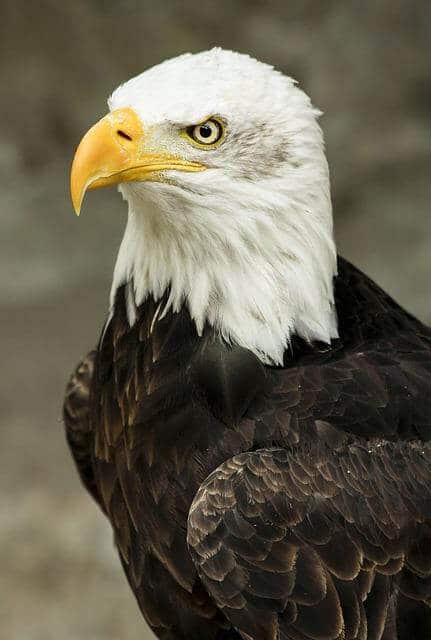
#4. Bald eagles have incredible eyes. Firstly, they have two centers of focus, giving them the ability to see forward and sideward simultaneously. They also have two eyelids. One is see-through, which they can close to moisten their eyes whilst still being able to see.
#5. Bald eagles are extremely fast divers when hunting for prey, capable of reaching up to 100 miles per hour. However, during regular flight, they can only travel around 30 miles per hour.
#6. As with most animals, a bald eagle’s lifespan is longer when in captivity. In captivity, they can reach around 50 years old. Whereas in the wild it’s normally 35. The oldest known bald eagle that lived in the wild was killed after getting hit by a car in New York, in 2015. The eagle was 38 years old.
Related Read: How Much Can Bald Eagles Tolerate?
#7. Bald eagles can be known as kleptoparasitic. This means that they have a tendency to supplement their food intake by stealing prey procured by other birds. Bald eagles will watch other birds, scanning them from tall perches. If another bird catches a sufficient food source, the eagle will chase it until it lets the food go.
#8. The largest bald eagles tend to live in Alaska, weighing up to 17 pounds.
#9. Before human settlement, bald eagles lived in abundance in Northern America. Due to human activities and persecution, their numbers declined so much that they became endangered. So many bald eagles were killed by bounty hunters that an act was passed to make it illegal. Unfortunately, DTT, an insecticide used for agriculture after WW2 caused more problems. It began to affect higher up the food chain, making bald eagle eggs too thin to survive. At one point, there were only 471 pairs of bald eagles in Northern America.
#10. In 1995 bald eagles luckily went from endangered to threatened, and in 2007 they were out of the danger zone. There are now an estimated 316,700 pairs of bald eagles.
Conclusion
Contrary to much confusion, the bald eagle is not really bald. The dignified creature actually boosts a sublime, bright, white-feathered head. However, immature bald eagles can be easily mistaken for golden eagles, as they don’t develop their white head until they are 4 or 5 years old.
Although the name ‘bald eagle’ seems deceiving at first glance, when you discover a bit more depth it actually makes sense. This regal creature has been the national bird of America since 1782, chosen due to its strength, courage, and liberty.
Young bald eagles can be easily mistaken for golden eagles, however, fully grown adults are obvious to distinguish. Bald eagles have brilliant white-feathered heads, whereas the golden eagle is brown all over.
You May Also Like To Read:

